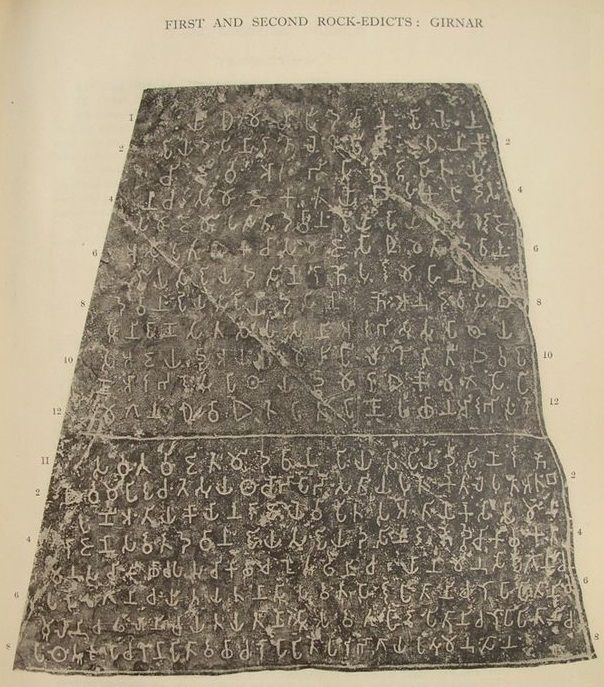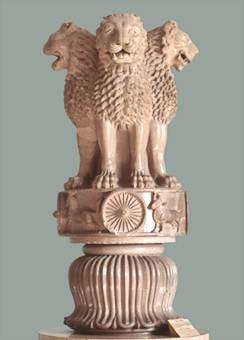Apr 19, 2024
Apr 19, 2024
The tricolored flag of India has the picture of a wheel with twenty-four spokes in the center. We all know it as Ashoka’s wheel (chakra). The symbol of the wheel and the pillar with the lion capital had languished as part of the scenery in India for many centuries. Only in the 19th century it was recognized as created by one of India’s greatest emperors. King Ashoka’s story is a strange one, as strange as the scribbles on rock surfaces, scattered from Afghanistan and Nepal to Karnataka.
Legend of Ashoka:
About 225 years after Buddha’s death, there came a powerful king, who had established an empire the size of which would never again be matched by any other king in India. His grandfather, Chandragupta Maurya had established the first empire in India in the wake of Alexander’s withdrawal from Punjab. Pataliputra (Patna) in the east was the capital of Maurya Dynasty.
The name of Ashoka (reign: 269 – 232 BC.) was known through Pali texts from Sri Lanka. Dynastic hierarchy of the Mauryas was mentioned in texts called Mahavamsha. Ashoka was mentioned in some Buddhist texts but it was difficult to separate fact from fiction. Megasthenes, a Greek explorer and ethnographer had recorded the impressive rule of Maurya dynasty but that was during the rule of Chandragupta. Ashoka remained just a name among countless erstwhile Indian kings; a cruel and violent king who was transformed by Buddhism to become a kind and benevolent king. This was the myth but yet the proof was there in plain sight all over India. The script on the rock surfaces had fallen into disuse and for centuries no one had made the connection between Ashoka and the inscriptions.
Astonishingly, Indians had first forgotten how to read the script and then the memory of a great king eluded them. When historians and archeologists of British East India Company, who had founded the Asiatic Society and the Archeological Survey of India in the 18th century, began asking the locals about the tall pillars and rock faces with strange writings, the answer baffled them.
In the local legend Lord Brahma himself was credited with the writings (hence the name Brahmi script). In many places the rocks had been considered divine. The story gets even better about the pillars. The legendary strongman Bhima of Mahabharata had used them as walking sticks, they claimed. Such was the level of ignorance!
Devanamapiya Piyadasi aka Ashoka:
James Prinsep, a brilliant man who was endowed with a keen intellect and astute observation, between the years 1836 and 1838 deciphered the Brahmi script. Working in the mint in Calcutta had given him the unique opportunity to see letters on ancient coins with an unreadable script. With diligent work spanning over more than 10 years he was able to resurrect the dead script of Brahmi.
All the writings, which were edicts and decrees, were signed off by a king named Devanamapiya Piyadasi (Beloved of God, King Piyadasi). Prinsep received the Pali documents from Sri Lanka. He was able to determine that King Devanamapiya Piyadasi was none other than king Ashoka. In 1915 some rock inscriptions were found in Raichur district in Karnataka (and another minor rock in Madhya Pradesh) with names of both King Piyadasi and Ashoka, confirming Prinsep’s observation.

Ashoka’s edict in Brahmi script
Essence of the Edicts:
Most of the writings on rocks were orders and decrees for the population to follow. Civil amenities for citizens and provision for travelers were written down as public service messages. Some of the ideas were borrowed from Jains, especially the sanctity of all life (ahimsa was a Jain idea). Meat eating was discouraged but not banned. Death penalty was also removed. Preservation of many species (specified by name - Ganges porpoise, rhino and even white ants) and prevention of deforestation were stressed in many rock edicts. Tolerance of other religions and abstinence from speaking ill of neighbor’s faith (because all religions aim at the same end, of purity of mind) were astonishingly spelled out. Though name of Gautama Buddha is mentioned in some of the writings, there is no attempt to conduct religious teachings or expound on Buddhist philosophy.
Ashoka’s rule and transformation:
Ashoka notoriously ascended the throne after much fratricide and violence. He was unattractive as well as ungainly in appearance. But he was a good administrator and had served as viceroy of Ujjain under his father. There he met and fell in love with a beautiful daughter of a merchant, Devi by name. They had a son Mahinda and a daughter Samghamitta, who would be his ambassadors to spread Buddhism in Sri Lanka and the Far East in the future. However, after becoming the king, Ashoka married other women and his chief queen was a highborn woman Asandhimitta.
Ashoka consolidated his position and expanded his kingdom. He embraced a life of pleasure and earned the nickname “Kamashoka.” Later when he was seen to exhibit violence and wickedness his nickname changed to “Chandalashoka.” It was during a brutal war with untold number of casualties in Kalinga (Orissa), in the eighth year of his rule that Ashoka had a change of heart. The bloodshed and mayhem of war prompted the king to become a pacifist and he embraced Buddhism perhaps with the influence from Devi, who was a Buddhist. Just like when Roman Emperor Constantine embraced Christianity, which helped propel Christianity from a fringe cult to a major religion, Ashoka’s conversion helped spread Buddhism not only in India but also in rest of Asia. Buddhism enjoyed a thousand years of influence in India following Ashoka’s conversion.
It is difficult to separate legend and folklore from facts in India. Ashoka’s story ends with a sad ending. It hints at a monarch (chakravartin) who might have lost all power before his death (in 232 BC). He had showed interest in donating all his wealth at his death to the Buddhists but his ministers and sons conspired to stop him. His sole possession at the end of his life was half a mango. This goes along the Buddhist theme that suffering is a human trait, even for a mighty emperor.
Ashoka worked too hard to create a perfect society. He was not satisfied with his colossal work. After dispersing many edicts and pillars all across his empire, he still lamented in one of his inscriptions, “I am never fully satisfied with the end product of all my work, my exertions and the conclusion of my business…But work I must for the public good.”

Once Ashoka’s story was again laid out in front of Indians as a gentle benevolent leader, who had transformed himself from a wicked king, he instantly achieved the status of sainthood. They embraced him whole-heartedly. He regained his rightful place in history as one of the greatest kings to rule India. Framers of the constitution of Republic of India, and the designers of the Indian flag paid homage by using his ideas and symbols.
The Ashoka pillar with the four lions (lion capital) has become the symbol of independent India.
Images sourced from the web
08-Jan-2015
More by : Dr. Neria H. Hebbar